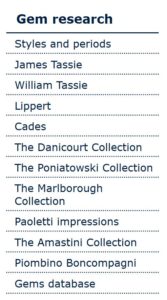This page is a listing of various sources and writings that I have found when researching the history and background information about intaglios.
Don’t forget to check out the sub menu pages of “Resources” — “Charles W King“, and the sub menu pages of “Personalities” — “James Tassie“, and “Josiah Wedgwood“.
Although intaglios date back to ancient times, the literature or works and writings about carved gems, their history, use, makers, and owners that are readily available to today’s collector (without gaining access to the holdings of the renowned museums) date mostly from the mid 18th century. Over the years that I have been collecting intaglios, I have obtained a few books and a fair number of references about them and associated topics (mostly online). What follows is a list of what I’ve found with links to the online references. It’s a start. There are many, many more out there.
THE PRIMO SITE FOR CLASSICAL INTAGLIO RESEARCH
The foremost source of information and images about classical engraved gems, more specifically intaglios, are the Gem Research pages of the The Classical Art Research Centre found at https://www.beazley.ox.ac.uk/gems/default.htm .
Most contemporary amateur collectors of intaglios will never own a fine classic intaglio (either because of the high cost or the fact that very few become available on the open market today), but one might be able to obtain an 18th or 19th century reproduction or cast of one. Often, at least in my case, when the opportunity to purchase such an item arises one must act on a combination of past experience and instinct, there is little time to research the background of the piece. The fun happens when you get home, hoping the 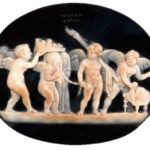 buy was a good one, and start to do the research. The place to start is the Gem Research page of the The Classical Art Research Centre. (The Classical Art Research Centre at the University of Oxford leads and supports research on ancient art. At its heart is the Beazley Archive, which contains the world’s largest collection of photographs of ancient Greek painted pottery, as well as relevant books and offprints, extensive material on the history of gem-collecting, and thousands of other documents and photographs relating to classical archaeology and to Sir John Beazley. The Beazley Archive’s online databases and our other web resources are freely available through this site.)
buy was a good one, and start to do the research. The place to start is the Gem Research page of the The Classical Art Research Centre. (The Classical Art Research Centre at the University of Oxford leads and supports research on ancient art. At its heart is the Beazley Archive, which contains the world’s largest collection of photographs of ancient Greek painted pottery, as well as relevant books and offprints, extensive material on the history of gem-collecting, and thousands of other documents and photographs relating to classical archaeology and to Sir John Beazley. The Beazley Archive’s online databases and our other web resources are freely available through this site.)
The main menu for the Gem Research pages leads one to a number of online databases –
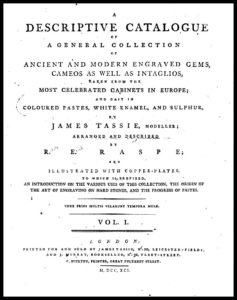 The place to start is the James Tassie tab. The URL link is https://www.beazley.ox.ac.uk/gems/tassie/default.htm This database contains both images (two of each item, each with alternate lighting) and descriptions of over 15,000 of “Mr James Tassie’s Collection of Pastes and Impressions from Ancient and Modern Gems.” The text of the descriptions is from the “Descriptive Catalog” of Tassie’s works by R. E. Raspe, 1791. Perusal of the images, which are somewhat categorized by type, and their associated description is of great assistance when trying to identify a classical intaglio.
The place to start is the James Tassie tab. The URL link is https://www.beazley.ox.ac.uk/gems/tassie/default.htm This database contains both images (two of each item, each with alternate lighting) and descriptions of over 15,000 of “Mr James Tassie’s Collection of Pastes and Impressions from Ancient and Modern Gems.” The text of the descriptions is from the “Descriptive Catalog” of Tassie’s works by R. E. Raspe, 1791. Perusal of the images, which are somewhat categorized by type, and their associated description is of great assistance when trying to identify a classical intaglio.
The more time you spend with these databases the more value you’ll derive from them. They are a great resource!
ENGRAVED GEMS: A HISTORICAL PERSPECTIVE
By Fred L. Gray in 1983
“Such innocuous events as the creation of the pre-gummed envelope and the modem postal system contributed to the demise of the engraved gem seal. During the thousands 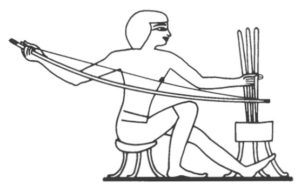 of years that the seal served as man’s most important mark of identification, however, gem engraving reigned as one of his most significant art forms. This article traces the-history of engraved gems from primitive amulets through cylinder seals, scarabs, scaraboids, and ringstones, to the more recently introduced cameos. Also discussed is the engraving process itself, how to evaluate an engraved gem, and more recent developments in the materials and methods used to engrave gems.”
of years that the seal served as man’s most important mark of identification, however, gem engraving reigned as one of his most significant art forms. This article traces the-history of engraved gems from primitive amulets through cylinder seals, scarabs, scaraboids, and ringstones, to the more recently introduced cameos. Also discussed is the engraving process itself, how to evaluate an engraved gem, and more recent developments in the materials and methods used to engrave gems.”
Gray, Fred L. “ENGRAVED GEMS: A HISTORICAL PERSPECTIVE.” Gems & Gemology, Winter 1983, Vol. 19, No. 4, pp. 191-201 http://www.gia.edu/gems-gemology/winter-1983-history-gems-gray , accessed 2016 11 12
The entire article can be accessed using the above noted link.
COLLECTING ENGRAVED GEMS
Both Ancient and Later Examples of the Glyptic Art Are Available for the Gem Enthusiast
By Gardner Teall in 1922
“DIFFICULT indeed would it be to conceive of a time when the love of jewelry did not play some part in personal adornment. If prehistoric man engraved figures of mammoths on selected pieces of ivory tusk, that same decorative instinct as surely had led him to conceive the beginnings of trinkets for the person. 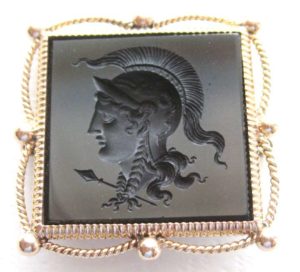 The ancientry of historic jewelry is well established. Babylonia, Assyria, Egypt, Greece, Rome–civilizations of these ancient states produced marvelous pieces of the jeweler’s craft, things that reached so high a state of special perfection that it is the despair of the modern craftsman to attempt to compete with their workmanship.
The ancientry of historic jewelry is well established. Babylonia, Assyria, Egypt, Greece, Rome–civilizations of these ancient states produced marvelous pieces of the jeweler’s craft, things that reached so high a state of special perfection that it is the despair of the modern craftsman to attempt to compete with their workmanship.
“From earliest times engraved gems have found great favor in jewelry. The ancient signet rings which have come down to us stand testimony to this, also the Biblical references in the Book of Genesis and elsewhere,—the signet with which Darius sealed up the lion’s den (Gen. xii. 42), the signet which Judah found so discomfiting (Gen. xxxviii) and the signet with which Queen Jezebel signed the false letters about the vineyard of Naboth (Dan. vi. 17), to note a few instances of such mention. Undoubtedly these signet rings were set with engraved gems, cut intaglio. In the British Museum there is an egg-shaped piece of pink-veined marble, some 2 1/2” long, pierced from base to apex and engraved with a Babylonian inscription which has been deciphered to read as follows, in translation: “I, Sargon the King, King of Agade have dedicated to Samos in Sappira”. This ancient intaglio has been determined by authorities to have been cut 3900 B. C., 5721 years ago, think of it! One of the most ancient evidences of sophisticated art.”
“Both Ancient and Later Examples of the Glyptic Art Are Available for the Gem Enthusiast” By Gardner Teall House & Garden Magazine September 1922 Vol 42 pp50, 104, & 106. The article was last accessed on 2019 09 25 at https://archive.org/details/housegarden42greeuoft/page/n189
(It’s an interesting period magazine with lots of home related ads)
For a copy of a pdf file of just the article pages —
